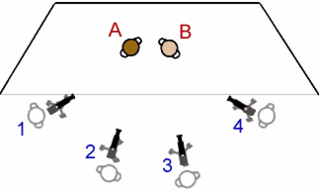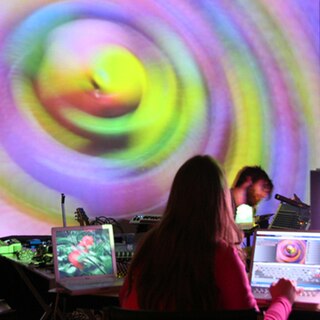A music video is a video that integrates a song or an album with imagery that is produced for promotional or musical artistic purposes. Modern music videos are primarily made and used as a music marketing device intended to promote the sale of music recordings. These videos are typically shown on music television and on streaming video sites like YouTube, or more rarely shown theatrically. They can be commercially issued on home video, either as video albums or video singles. The format has been described by various terms including "illustrated song", "filmed insert", "promotional (promo) film", "promotional clip", "promotional video", "song video", "song clip", "film clip", "video clip", or simply "video".

Videotape is magnetic tape used for storing video and usually sound in addition. Information stored can be in the form of either an analog or digital signal. Videotape is used in both video tape recorders (VTRs) and, more commonly, videocassette recorders (VCRs) and camcorders. Videotapes have also been used for storing scientific or medical data, such as the data produced by an electrocardiogram.

Kinescope, shortened to kine, also known as telerecording in Britain, is a recording of a television programme on motion picture film, directly through a lens focused on the screen of a video monitor. The process was pioneered during the 1940s for the preservation, re-broadcasting and sale of television programmes before the introduction of quadruplex videotape, which from 1956 eventually superseded the use of kinescopes for all of these purposes. Kinescopes were the only practical way to preserve live television broadcasts prior to videotape.

American Bandstand (AB) is an American music-performance and dance television program that aired regularly in various versions from 1952 to 1989, and was hosted from 1956 until its final season by Dick Clark, who also served as the program's producer. It featured teenagers dancing to Top 40 music introduced by Clark.

Ampex Data Systems Corporation is an American electronics company founded in 1944 by Alexander M. Poniatoff as a spin-off of Dalmo-Victor. The name AMPEX is a portmanteau, created by its founder, which stands for Alexander M. Poniatoff Excellence. Ampex operates as Ampex Data Systems Corporation, a subsidiary of Delta Information Systems, and consists of two business units. The Silicon Valley unit, known internally as Ampex Data Systems (ADS), manufactures digital data storage systems capable of functioning in harsh environments. The Colorado Springs, Colorado, unit, referred to as Ampex Intelligent Systems (AIS), serves as a laboratory and hub for the company's line of industrial control systems, cyber security products and services and its artificial intelligence/machine learning technology.
Robert Blake Harper was a Canadian-born radio and video DJ.

Turner Broadcasting System, Inc. was an American television and media conglomerate founded by Ted Turner in 1965. Based in Atlanta, Georgia, it merged with Time Warner on October 10, 1996. As of April 2022, all of its assets are now owned by Warner Bros. Discovery (WBD). The headquarters of Turner's properties are largely located at the CNN Center in Downtown Atlanta, and the Turner Broadcasting campus off Techwood Drive in Midtown Atlanta, which also houses Turner Studios. Some of their operations are housed within WBD's corporate and global headquarters inside 30 Hudson Yards in Manhattan's West Side district, and at 230 Park Avenue South in Midtown Manhattan, both in New York City, respectively.

WXIA-TV is a television station in Atlanta, Georgia, United States, affiliated with NBC. It is owned by Tegna Inc. alongside MyNetworkTV affiliate WATL. The two stations share studios at One Monroe Place on the north end of midtown Atlanta; WXIA-TV's transmitter is located in the city's east section, near Kirkwood. Atlanta is the largest television market where the NBC station is not owned and operated by the network.

WATL is a television station in Atlanta, Georgia, United States, affiliated with MyNetworkTV. It is owned by Tegna Inc. alongside NBC affiliate WXIA-TV. The two stations share studios at One Monroe Place on the north end of midtown Atlanta. WATL's transmitter shares a broadcast tower with several other local stations near North Druid Hills, just northeast of the city.

Georgia Championship Wrestling is an American professional wrestling promotion based in Atlanta, Georgia. The promotion was affiliated with what had been the world's top sanctioning body of championship titles for decades before, the National Wrestling Alliance (NWA), and ran live wrestling shows throughout its geographic "territory" of Georgia. The company was also known for its self-titled TV program, which aired on Atlanta-based superstation WTBS from the 1970s until 1984 when its timeslot was purchased by the World Wrestling Federation.

WPCH-TV, branded on-air as Peachtree TV, is a television station in Atlanta, Georgia, United States, affiliated with The CW. It is owned by locally based Gray Television alongside CBS affiliate and company flagship WANF, and low-power, Class A Telemundo affiliate WKTB-CD. WPCH-TV and WANF share studios on 14th Street Northwest in Atlanta's Home Park neighborhood; WPCH-TV's transmitter is located in the Woodland Hills section of northeastern Atlanta.

Sidewalks Entertainment (1988–present) is a weekly American television series that is a combination of a talk show, magazine show and variety show featuring celebrity interviews, music, artistic and novelty acts, and rising performers. The 30-minute program is primarily produced in the San Francisco Bay Area with segments from other parts of the country, including Los Angeles and New York.

The multiple-camera setup, multiple-camera mode of production, multi-camera or simply multicam is a method of filmmaking and video production. Several cameras—either film or professional video cameras—are employed on the set and simultaneously record or broadcast a scene. It is often contrasted with a single-camera setup, which uses one camera.

VJing is a broad designation for realtime visual performance. Characteristics of VJing are the creation or manipulation of imagery in realtime through technological mediation and for an audience, in synchronization to music. VJing often takes place at events such as concerts, nightclubs, music festivals and sometimes in combination with other performative arts. This results in a live multimedia performance that can include music, actors and dancers. The term VJing became popular in its association with MTV's Video Jockey but its origins date back to the New York club scene of the 1970s. In both situations VJing is the manipulation or selection of visuals, the same way DJing is a selection and manipulation of audio.
Music television is a type of television programming which focuses predominantly on playing music videos from recording artists, usually on dedicated television channels broadcasting on satellite, cable, or Streaming Platforms.

The Cable Music Channel (CMC) was an American basic cable channel that was owned by the Turner Broadcasting System. The all-music video channel was created by Ted Turner and launched in 1984, providing the first national competition to MTV. Turner later stated that the channel existed at the behest of the cable industry as a defense mechanism against MTV's unsuccessful attempts to increase the fees that cable providers paid to carry the channel by twofold; Turner offered the channel without any carriage fees.
Classic Whitney: Live from Washington, D.C., were live concerts by Whitney Houston.
Electronovision was a process used by producer and entrepreneur H. William "Bill" Sargent, Jr. to produce a handful of motion pictures, theatrical plays, and specials in the 1960s and early 1970s using a high-resolution videotape process for production, later transferred to film via kinescope for theatrical release.

TBS, stylized as tbs, is an American basic cable television network owned by the Warner Bros. Discovery U.S. Networks division of Warner Bros. Discovery (WBD). It carries a variety of programming, with a focus on comedy, along with some sports events, including Major League Baseball, Stanley Cup playoffs, NCAA men's basketball tournament and the weekly professional wrestling show AEW Dynamite. As of September 2018, TBS was received by approximately 90.391 million households that subscribe to a pay television service throughout the United States. By June 2023, this number has dropped to 71.3 million households.
The Kendall Ross Bean - Chopin Polonaise in A Flat was one of the first classical music videos to be broadcast in the United States and Canada on 24 July 1986.